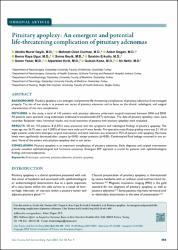| dc.contributor.author | Geyik, Abidin Murat | |
| dc.contributor.author | Durmaz, Mehmet Ozan | |
| dc.contributor.author | Doğan, Adem | |
| dc.contributor.author | Kaya Uğur, Berna | |
| dc.contributor.author | Geyik, Sırma | |
| dc.contributor.author | Erkutlu, İbrahim | |
| dc.contributor.author | Yaşar, Soner | |
| dc.contributor.author | Kırık, Alpaslan | |
| dc.contributor.author | Köse, Gülşah | |
| dc.contributor.author | Nehir, Ali | |
| dc.date.accessioned | 2022-04-28T11:42:30Z | |
| dc.date.available | 2022-04-28T11:42:30Z | |
| dc.date.issued | 2022 | en_US |
| dc.identifier.citation | Geyik AM, Durmaz MO, Dogan A, Kaya Ugur B, Geyik S, Erkutlu İ, et al. Pituitary apoplexy: An emergent and potential lifethreatening complication of pituitary adenomas. Ulus Travma Acil Cerrahi Derg 2022;28:483-489. | en_US |
| dc.identifier.issn | 1306-696X / 1307-7945 | |
| dc.identifier.uri | https://hdl.handle.net/20.500.12809/9953 | |
| dc.description.abstract | BACKGROUND: Pituitary apoplexy is an emergent and potential life-threatening complication of pituitary adenomas if not managed properly. The aim of our study is to present our series of pituitary adenomas and to focus on the clinical, radiological, and surgical characteristics of this rare complication. METHODS: In this study, a total of 143 patients with pituitary adenoma underwent surgical treatment between 2016 and 2018. All patients were operated using endoscopic endonasal transsphenoidal (EET) technique. The data of pituitary apoplexy cases were recorded. Resection rates, hormonal results, and visual outcomes of patients with pituitary apoplexy were evaluated. RESULTS: Of the 143 patients, 8 (5.59%) were presented with the symptoms and radiological findings of pituitary apoplexy. The mean age was 26.75 years, and 4 (50%) of them were male and 4 were female. Pre-operative mean Knosp grading score was 2.1 All of eight patients underwent emergent surgical intervention and total resection was achieved in 75% of patients with apoplexy. Hormone levels were significantly decreased after surgery (p 0.05), except prolactin (p 0.05). Cerebrospinal fluid leakage occurred in one pa-tient. None of the patient with pituitary apoplexy died in our series. CONCLUSION: Pituitary apoplexy is an important complication of pituitary adenomas. Early diagnosis and surgical intervention provide excellent ophthalmological and hormonal outcomes. Emergent EET approach is crucial for patients with ophthalmological findings and macroadenomas. | en_US |
| dc.item-language.iso | eng | en_US |
| dc.publisher | TURKISH ASSOC TRAUMA EMERGENCY SURGERY | en_US |
| dc.relation.isversionof | 10.14744/tjtes.2021.93539 | en_US |
| dc.item-rights | info:eu-repo/semantics/openAccess | en_US |
| dc.subject | Endoscope | en_US |
| dc.subject | Outcome | en_US |
| dc.subject | Pituitary adenoma | en_US |
| dc.subject | Pituitary apoplexy | en_US |
| dc.title | Pituitary apoplexy: An emergent and potential life-threatening complication of pituitary adenomas | en_US |
| dc.item-type | article | en_US |
| dc.contributor.department | MÜ, Sağlık Bilimleri Fakültesi, Hemşirelik Bölümü | en_US |
| dc.contributor.authorID | 0000-0002-9414-6582 | en_US |
| dc.contributor.institutionauthor | Köse, Gülşah | |
| dc.identifier.volume | 28 | en_US |
| dc.identifier.issue | 4 | en_US |
| dc.identifier.startpage | 483 | en_US |
| dc.identifier.endpage | 489 | en_US |
| dc.relation.journal | ULUSAL TRAVMA VE ACIL CERRAHI DERGISI-TURKISH JOURNAL OF TRAUMA & EMERGENCY SURGERY | en_US |
| dc.relation.publicationcategory | Makale - Uluslararası Hakemli Dergi - Kurum Öğretim Elemanı | en_US |


















